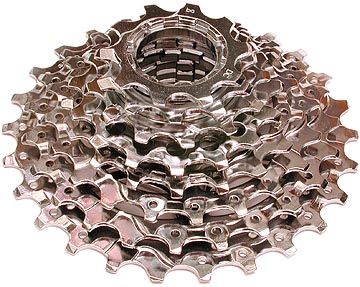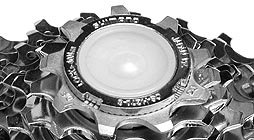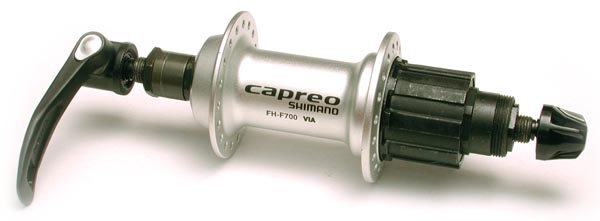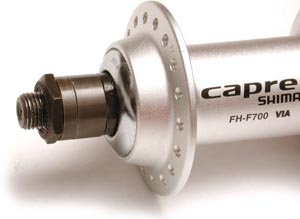Das Shimano Capreo System
Small wheels for bicycles have real value for certain applications. Chief among these are folding bikes and "compact" recumbents. Reducing the size of the wheels allows the overall size of a bike to be reduced, and, in the case of many recumbent designs, allows the seat to be placed lower.
As tires improve, the increased rolling resistance of smaller tires becomes less of a concern than it formerly was, but one problem that has persisted is the difficulty of getting decent high gears with small drive wheels.
The gearing of a normal sprocket driven wheel is proportional to the wheel diameter, so if you use smaller wheels with the same sized sprockets you would use for a bike with full-sized wheels, all of your gears will be lower.
Lower lows are rarely a problem, and by using a tight "racing style" cluster in back, you can raise the low gears easily enough if you don't want super low gearing.
The top end, however, has always been a problem with small wheels. There are only three ways to get a decent high gear with small wheels:
- Bigger Chainrings
- If you have 406 mm (20") wheels, you would need to install an 69 tooth chainring to be equivalent to a 52 tooth with common 622 mm wheels.
- If you have 349 mm (16") wheels, you would need to install an 86 tooth chainring to be equivalent to a 52 tooth with common 622 mm wheels!
- Even if you could find such big chainrings at an affordable price, you could never find a front derailer that would do a decent job of shifting it.
- Internal Gears
- A planetary internal gear system, either built into the rear hub or the bottom bracket can be used to to supplement the derailer gearing, and give a decent high gear. These systems are expensive, heavy and lose efficiency to friction, so they're not universally popular.
- Smaller Rear Sprockets
- This is potentially the simplest and least expensive way to go, but until recently this was not an option. The smallest sprockets generally available have been 11 teeth, not enough to give a serious high gear with normal-sized chainrings.
- Special, very expensive freewheels with 9-tooth sprockets have been available for Moulton bikes, but Moulton has been reluctant to market them to owners of other brands of bikes.
- Enter the Shimano Capreo system! This is Shimano's first group intended specifically for small wheel bikes. The Capreo system includes:
- FH-700 Freehub.
- Special 9-speed Freehub, 135 mm spacing, 24, 32 or 36 holes.
- CS-HG70-s Cassette
- 9-10-11-13-15-17-20-23-26 tooth sprockets.
- RD-700 Rear derailer.
There are other items included in the Capreo "group" including brakes, rear derailer, crank, shifter, but there is nothing all that special about those. Even the Capreo rear derailer is not necessary to the system, but the Capreo cassette and Capreo Freehub must be used together.
The Capreo cassette won't fit any other hub. The Capreo hub won't accept any other cassette.
Die Capreo Kassette
The 5 largest sprockets of the Capreo cassette are standard Shimano cassette sprockets: 15, 17, 20, 23 and 26 teeth. They are individual sprockets, not linked by a spider, but the 4 largest (17-26) are held together by rivets. There is, however nothing preventing an adventurous user from grinding off the heads of the rivets and customizing the bottom end of the gearing.
The 4 smallest sprockets, 9, 10, 11 and 13 teeth are all special.
- The 13 tooth sprocket engages the main splines of the Freehub, but the outside of it is recessed to allow the special 11 to reach the splines. This particular 13 is also used on a couple of other 9-speed models.
- The 11 tooth has male splines that engage the Capreo Freehub body, and female splines on the outside to engage the 10.
- The 10 tooth has male splines that engage the special 11, and female splines on the outside to engage the 9.
- The 9 tooth has male splines that engage the special 10 and there is a very small female threaded lockring that holds everything together.
Die Capreo Freilaufnabe
The Capreo Freehub has a special body designed to accommodate then smaller diameter of the 9 and 10 tooth sprockets. Otherwise, it appears pretty much similar to other Shimano Freehubs.
Instead of using the male threaded lockring common to other Hyperglide cassettes, the Capreo uses a much smaller female threaded lockring, using the same 22 x 1 mm thread as common crank extractors.
It comes set up for 135 mm spacing, but the left side of the axle has two removable spacing washers, one of which is 4 mm and the other 8 mm thick. By removing spacers and trimming the axle, this hub could easily be adapted to other spacings, though this would result in a wheel with more dish.
Quelle
Dieser Artikel basiert auf dem Artikel The Shimano Capreo System von der Website Sheldon Browns. Originalautor des Artikels ist Sheldon Brown.
<img size=1x1>http://vg04.met.vgwort.de/na/198c3254a88b4122acd21aeeada9e2d7</img>







